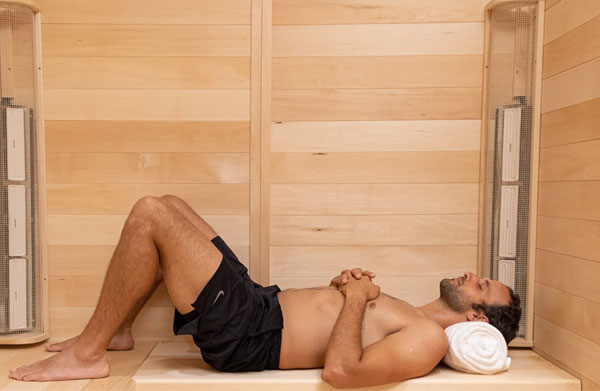Saunas are designed to heat your body enough to trigger your sweat glands. However, the temperature that saunas reach differs depending on the type you’re sitting in. Traditional saunas (European style) are designed to reach very high temperatures, sometimes almost boiling point, which can make you feel uncomfortably hot and make it hard to breathe inside the room. That’s actually how it’s designed to work: by superheating the air so your lungs overheat and trigger the autonomic nerve response which raises your blood pressure, your heart rate, and your blood temperature.
The autonomic nerve regulates your body’s blood temperature, among other automatic functions. When you breathe super hot air it kicks in to pump blood to the extremities to cool off the core organs. Conversely if you breathe super cold air the same system slows your blood flow to keep your core organs wam, attempting to regulate you to 98.6 F, or “normal temperature”. When it’s cold air the extremities are starved of blood which can lead to frostbite. When the air is hot the extremities are over supplied with blood which triggers the sweat glands to release warm water (sweat) to cool you down.
Infrared saunas also make you sweat, but they don’t get hot enough to stifle your breathing. Ideally, they will not trigger the autonomic nerve response, and thus do not raise your heart rate, blood temperature, or blood pressure. It’s a much more relaxing experience, more like a warm day than a volcano. Find out more about just how hot an infrared sauna can get.
How Infrared Saunas Work
Infrared saunas use infrared (below “red-hot”) heating elements. When properly designed with natural materials they will warm your skin just enough to trigger your sweat glands. The air temperature inside does not need to be so hot as to overheat your lungs and trigger your autonomic response. Your skin is the heats’ target, instead of your lungs. The experience should not raise your core body temperature and does not need to exceed 100F inside. The infrared heat allows almost anyone to benefit from saunas, even if they traditionally feel saunas are too hot to tolerate. It’s like being in a greenhouse in July, rather than an oven at Thanksgiving. After about 20 minutes most people start breaking a good sweat, and within 30 minutes they are usually drenched with sweat. When you leave the sauna, your body temperature is still normal and you can go about your day, instead of having to lay down and recover because your body temperature has been elevated.
Temperatures of Infrared Saunas
Traditional saunas can reach temperatures between 60 and 80 degrees Celsius (140 to 176 degrees Fahrenheit). Some “serious” sauna enthusiasts like it even hotter. These temperatures are high enough to raise your body temperature starting with your first breath, which can affect your breathing and comfort levels. When you step into infrared saunas you’re typically walking into temperatures that are between 27 and 28C (82 to 84F). While you’re in the sauna, the temperature should gradually rise to around 37C (98.6 F) depending on your settings. Some people like to let it rise slightly over core temperature to around 40C or 104F. This lower temperature gives you a chance to adjust to the heat without putting stress on your body. Your core body temperature won’t go up in infrared saunas, even though you’ll be sweating.
Benefits of Lower Sauna Temperatures
When you use infrared saunas, you won’t be exposed to uncomfortably high temperatures as you would with a traditional sauna. Infrared saunas allow you to remain inside for longer periods of time without experiencing the heat discomfort factor. This means you’ll be sweating for a longer time, so that your body can eliminate toxins shown to be excreted in human sweat.. When you’re done using the sauna, you won’t feel exhausted or worn out. The higher temperatures of traditional saunas can make you feel tired afterwards due to the strain the heat places on your body.
Setting and Adjusting Sauna Temperatures
You don’t necessarily have to set your infrared sauna to the maximum temperature. If the heat starts to make you feel uncomfortable, you have the option to lower the setting. Some people even time their sauna to turn off after 25 minutes so they can sit inside a cooling sauna for their last five minutes, instead of an escalating heat. This technique allows you to sweat even more.
Find the Perfect High-Quality Infrared Sauna, If you’re interested in getting an infrared sauna for your home or business, please contact SaunaRay for more information on our products. We offer high-quality, environmentally friendly infrared saunas that are ideal for customers in Canada, the US, and worldwide. Our sauna options include athletic saunas, custom saunas, commercial saunas, and more.



